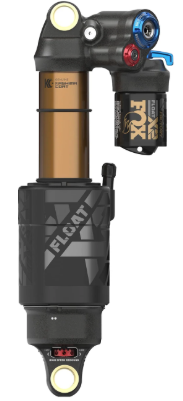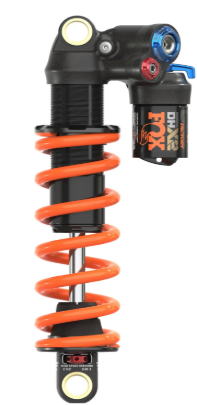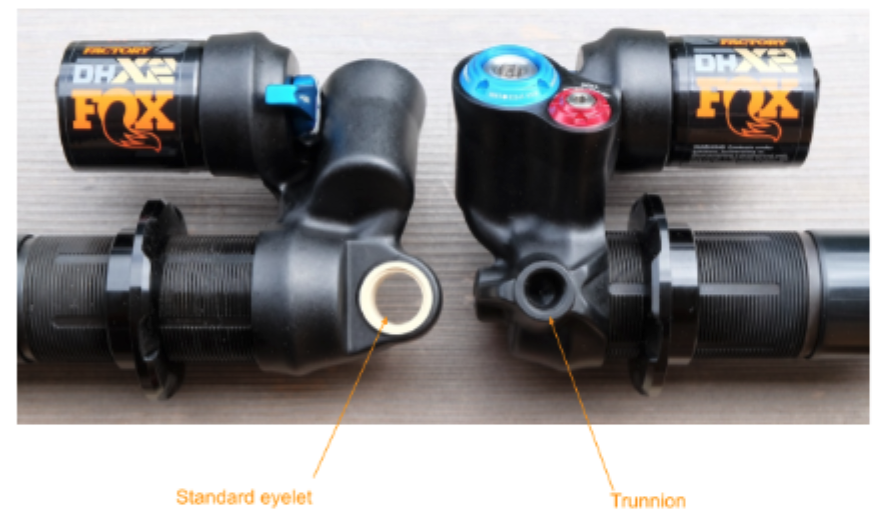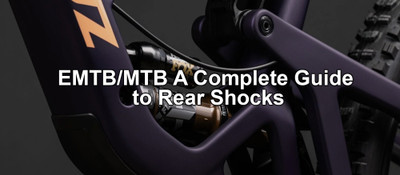Posted by Paul Hoyle on 3rd Oct 2025
The Magic Behind Your Rear Suspension
When you look at a mountain bike's front fork, what you see is what you get. The travel of the front fork is the same as the visible length of the inner tube (the stanchion) that slides into the lower part of the fork. If the stanchion is 150mm long and you use all of its available travel, the wheel moves up by 150mm. It's a simple, direct relationship.
Now, look at the back of the bike. The rear shock is much smaller and shorter than the front fork. But don't let its size fool you! The rear wheel still gets a lot of travel, often matching what the front fork provides.
This is because of the bike's suspension linkages, which are a series of small arms and pivots connecting the rear wheel to the shock. Think of these linkages like a powerful lever.
The rear linkages take the relatively short movement of the shock (its "stroke" or shaft length) and magnify it into a much larger movement at the rear wheel.
So, for example, a rear shock with a 60mm stroke can be connected to linkages that amplify its movement to create 150mm of rear wheel travel.
The key takeaway for a buyer: Don't worry about the small size of the rear shock. Thanks to clever engineering and the bike's linkage system, that small shock is able to deliver a much larger amount of travel to the rear wheel, keeping you comfortable and in control over bumps and drops.
Mountain Bike Rear Shock Guide
Rear shocks are the component that allows the rear triangle of a full suspension bike to move up and down. Like mountain bike forks they are designed to compress and decompress in a controlled manner to track the ground and absorb large impacts.
The Big Debate: Air Vs Coil
In the world of shocks we see two styles: Air shocks and Coil shocks. The only difference between these two is one uses an air controlled compression and rebound (through a compressed air chamber) whilst the other uses a physical metal spring, other than this they feature the same damper and internals.


Below is a few main points to consider when deciding between the two shock styles:
- Weight: Air shocks are usually a lot lighter than a coil as they don’t feature a heavy spring
- Adjustability: Air shocks provide a lot more adjustability, with air spring adjusters and volume spacers controlling ramp-up.
- Complexity: With all this adjustability comes complexity. Coil shocks are known to be simple and once set up don’t require much messing around.
- Sensitivity: Coil shocks offer superior small bump compliance, providing a smooth ride over rough terrain
What is Trunnion?

This is simply just a mounting system used on mountain bikes to connect the shock absorber to the bike frame. It typically consists of two pivot points that are integrated into the frame, providing a more robust and precise connection compared to traditional bolt-on mounting systems. This design often allows for a longer shock stroke and improved suspension performance, especially in demanding terrain.
How Do I Measure My Shock?
Shock sizing is presented in the following format - “A” x “B”. With A being the shock's eye to eye and B being the shock stroke.
The eye to eye is simply the measurement from the centre of the upper shock mounting to the centre of the lower shock mounting. The stroke then references how much the shock can travel into itself. This affects the rear bike's travel but rear travel is mainly determined by the frame design.
Shock Brands
Rear shocks will feature either the same or a slightly different version of the technology found on the forks. Below are tables showing what shocks each brand offers and how they differ.
Fox
There are a few key components that make up these suspension platforms and they also give them their specification:
Kashima:
- This is the coating that gives the stanchions its gold appearance. It is a porous coating that holds oil meaning the suspension can move through its travel smoother.
Grip X damper:
- This gives the fork, both adjustable compression and rebound with one point of adjustment for each.
Grip X2 damper:
- This damper features adjustable high and low speed on both the compression and rebound.
These parts are then fitted to forks under three different spec levels:
Performance series:
- Base damper, no Kashima
Performance Elite Series:
- The best damper no Kashima
Factory series:
- The best of Fox, best damper and Kashima
The below table shows the current 2025 Fox models and how they differ, these almost all come in all three spec levels.
| Model | Trunnion Compatibility | EST Weight | Piggy Bank | Discipline |
|---|---|---|---|---|
| DPS / DPX | No | 264g | Some | XC / Trail |
| Float X | Yes | 479g | Some | Trail / Enduro |
| Float X2 | Yes | 730g | Yes | Enduro / DH |
| DHX (Coil) | Yes | 862g | Yes | Trail / Enduro |
| DHX2 (Coil) | Yes | 774g | Yes | Enduro / DH |
Marzocchi
Marzocchi was taken over by Fox and their products contain the Fox technologies we discussed earlier.
Marzocchi products are known for their reliability, their components are often slightly heavier but the materials are often very durable.
| Model | Trunnion Compatibility | EST Weight | Piggy Bank | Discipline |
|---|---|---|---|---|
| Bomber Inline Shock | Yes | 410g | No | XC |
| Bomber CR Shock (Coil) | Yes | 590g | Yes | Trail / Enduro / DH / Freeride |
| Bomber Air Shock | Yes | 484g | Yes | Trail / Enduro / DH / Freeride |
RockShox
RockShox are world renowned for their suspension platforms and offer a huge range from entry-level to world cup winning technology.
Again we will see some main technologies, especially in the higher spec levels:
Adjustable Hydraulic Bottom Out (AHBO):
- This allows you to adjust how resistant your shock is when nearing bottom out
Touch Down:
- Vivid's new position-sensitive damping system that's forgiving at the beginning of its travel while staying composed in the middle and end of the stroke.
RockShox Spec Levels
- Select: Entry level damper, rebound only
- Select +: Compression + rebound, Charger 2.1 RC2
- Ultimate: High/low speed compression and rebound adjustment with RockShox best parts
| Model | Trunnion Compatibility | EST Weight | Piggy Bank | Discipline |
|---|---|---|---|---|
| Sid | Yes | 252g | No | XC / DC |
| Deluxe | Yes | 313g | No | Trail |
| Super Deluxe | Yes | 458g | Yes | Enduro |
| Super Deluxe Coil | Yes | 902g | Yes | Enduro / Downhill |
| Vivid | Yes | 657g | Yes | Enduro / Downhill |
| Vivid Coil | Yes | 902g | Yes | Enduro / Downhill |
Öhlins
Ohlins are renowned for their high quality suspension systems in motor sports and they have recently moved into the world of mountain bikes and they are arguably making some of the best suspension on the market.
TTX Damping:
- The TTX system separates the compression and rebound damping circuits into two distinct tubes. This allows for more precise adjustment and better control over suspension behaviour.
- Offers high and low speed rebound damping.
Climb Mode:
- Lever adjustable lockout, to make it easier when pedalling uphill.
| Model | Trunnion Compatibility | EST Weight | Piggy Bank | Discipline |
|---|---|---|---|---|
| TXC2 | Yes | 255g | No | XC |
| TTX2 Air | Yes | 477g | Yes | Enduro/Trail/DH |
| TTX22M.2 (coil) | Yes | 650g | Yes | Enduro/Trail/DH |



